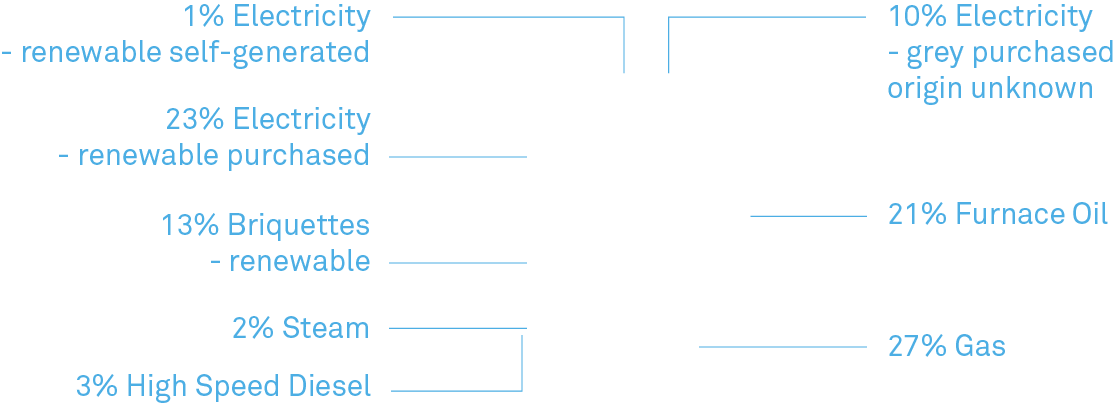

Back to overview

Scroll
down

Stahl is committed to the goal of limiting global temperature increase to 1.5°C above pre-industrial levels, as established in the 2015 Paris Climate Agreement. Our strategy to achieve this is detailed in the Stahl Climate Resilience & Adaption Plan. Reducing direct and indirect GHG emissions is the focus and Stahl is committed to setting emissions targets that are aligned with the Science Based Targets initiative (SBTi).

Energy and emissions at Stahl
Reducing GHG emissions is the fundamental element of our strategy for climate change mitigation. To achieve Scope 1 and 2 emissions reduction, we are working towards lower consumption of energy and investing in self-generated energy (solar). All our European sites are already sourcing 100% green electricity.
In 2021, our production volumes increased by 26% (versus 2020), while our absolute Scope 1 and 2 Scope emissions increased by 7%. That resulted in an energy intensity (consumption per kg produced) reduction of 15%.

ESG roadmap to 2030
2023/2030 goal: reduce CO2 emission intensity by 2% per year
2021 progress: 15% reduction compared to 2020

Energy and emissions at Stahl
Data verified and validated by Deloitte
*Intensity is related to production volumes (CO2/production volume). Scope 1: fuel combustion at our sites (gas, oil, diesel and renewable briquettes). No coal is used. Scope 2: purchased electricity, heat and steam. GHG emissions are reported in CO2e. Carbon dioxide equivalent (CO2e) emissions represent emissions of all greenhouse gases (CO2, CH4, N2O, HFCs, PFCs, and SF6), aggregated and converted to units of CO2e using global warming potential (GWP) values.

Stahl’s energy consumption is the sum of electricity, gas, oil, steam, renewable briquettes and high-speed diesel consumed at the manufacturing sites. No coal is used at our manufacturing sites. Stahl’s energy intensity (energy in TJ consumed/ton products produced) was 15% lower in 2021 compared to 2020. This reduction was in large part due to improved efficiencies at manufacturing sites.

ESG roadmap to 2030
2023: 3 / 11 sites renewable energy on-site 2030: 6 / 11 sites renewable energy on-site
The renewable energy we use includes energy we get from the network – in Europe for example, all four major sites are fueled by green energy. The increase in our use of renewable energy was also partly due to the solar panels that were implemented in Brazil in 2018.
We are also continuing with our on-site renewable energy program: in 2021, Stahl approved and commissioned new solar panel projects in India and Mexico. The projects are planned to be implemented in 2022, contributing to more renewable energy use as per our ESG Roadmap targets.
Overall, Stahl’s share of renewable energy (% of total energy consumption) increased from 35% in 2020 to 38% in 2021. Our energy intensity (energy in TJ consumed/ton products produced) reduced by 15% versus 2020.

Energy consumption
*Intensity is related to production volumes (energy consumption/production volume).


Energy sources
Data verified and validated by Deloitte
Energy and emissions through the value chain
We are taking further action to reduce our Scope 3 indirect emissions. A Scope 3 emissions target will be established in 2022, as part of our alignment to the Science Based Targets initiative (SBTi).
Greenhouse gas emissions are categorized into three groups or 'Scopes' by the most widely-used international accounting tool, the Greenhouse Gas (GHG) Protocol. Scope 1 covers direct emissions from owned or controlled sources. Scope 2 covers indirect emissions from the generation of purchased electricity, steam, heating and cooling consumed by the reporting company. Scope 3 includes all other indirect emissions that occur in a company’s value chain, both upstream and downstream, which are defined in 15 categories.
Data verified and validated by Deloitte

For each Scope 3 category, total emissions of GHGs (CO2, CH4, N2O, HFCs, PFCs, and SF6) are reported in metric tons of CO2 equivalent, excluding biogenic CO2 emissions and independent of any GHG trades, such as purchases, sales, or transfers of offsets or allowances.
Before calculating (in 2017), it was already assumed (based on expert judgement and competitors) that category 1 would be the largest category. Indeed our calculation model continues to show that category 1 is the major contributor to CO2e emissions in our value chain. To make sure the calculated categories reflect the GHG emissions of our company, the emphasis is on data quality (actual data instead of proxy) and availability. Understandably, the major contributor in this category are the raw materials that we buy from the chemical industry. We buy from the largest chemical companies, who are increasingly able to provide actual data (LCA), including carbon footprint data on the raw materials that we buy from them.

Scope 3 CO2 emissions per category
Data verified and validated by Deloitte

In 2022 Stahl will review all 15 categories for Scope 3 emissions as per the GHG protocol, with the help of an external consultant. It is likely that more products and services will be added to category 1 (for example, outsourced production and products for resale, which is likely to be a significant increase in CO2 emissions) and other categories. This comprehensive review will serve as a good base to set a target for Scope 3, which is aligned to the Science Based Target Initiative (SBTi) criteria.
Business travel
In 2021, Stahl’s business travel increased compared to 2020. However, the ongoing COVID-19 pandemic limited travel, which contributed to travel remaining below 2019 levels. The increased use of digital technology during the pandemic has had a positive effect on the way we meet: technology enabled us to organize online meetings that would previously have been held in person. We expect this will help us meet our 2023 goal of a 20% reduction in business travel.

ESG roadmap to 2030
Our 2030 goal is to reduce business travel CO2 emissions by 50% (vs 2019) while maintaining high levels of service and customer engagement.

By integrating a climate resilience plan into the Stahl strategy, we believe we can secure our future and be a positive force for climate action in our industry. In 2021, we communicated the Stahl Climate Resilience & Adaption Plan, which sets out our approach to climate risk mitigation, including our ambitious targets and how we plan to achieve them.

Climate change is a serious threat to the planet and to business. Almost all of our sustainability efforts are connected to climate change, including two of Stahl’s strategic focus areas: Sustainable Development and Renewable Feedstocks. We want to support the worldwide effort to limit the global temperature increase to 1.5˚C above pre-industrial levels – not only by reducing Stahl’s own impacts, but also by encouraging and helping the industry to take action.
Stahl’s climate targets
- Reduce Scope 1 and Scope 2 emissions by 2% each year from 2020-2030
- Establish a Scope 3 emissions reduction target in 2022
In 2021, we launched the Stahl Climate Resilience & Adaption Plan, which itself was one of the steps towards achieving our goal. In the Plan, we have set targets to reduce GHG emissions, and we will track and report on our progress in this Annual ESG report. To align with Stahl’s net-zero target for 2050, we need to reduce GHG emissions – Scopes 1, 2 and 3 – by 40-60% (compared to the baseline year 2015) by 2030. Our targets:
How we plan to get there
Using less energy and ensuring it is renewable will be key to achieving our Scope 1 and 2 targets. We plan to install more self-generating electricity (solar power) at selected sites, and we are continuously investing in energy-saving equipment.
We have a different starting point for Scope 3: the first step is to set a realistic target for emissions reduction. We will do this in 2022.
In the meantime, we are already making progress in reducing Scope 3 emissions, especially in our purchased goods and services (which is the largest category). We plan to continue reducing business travel, including with fewer flights, more online meetings, and through a smart working policy.
We can also make progress through innovation. Together with our Open Innovation and Procurement teams, the ESG team is setting up a CO2 impact model that calculates the current emissions and the reduction scenarios. For instance we calculate (using Life Cycle Assessment) the impact of solvent vs water based technologies, and what it would mean for the company to further phase out solvent based products. Although there is low availability of renewable feedstock alternatives, we will ramp up the replacement of fossil-fuel based raw materials with renewable feedstocks. We will also continue to phase out solvent-based products. We plan to measure our indirect raw material CO2 emissions based on LCA data from suppliers and the ECOINVENT/Simapro database.

Scope 3
(in tCO2e)
Scope 1 and 2
(in tCO2e)

Since 2015, we have been working to reduce our Scope 1 and 2 emissions by sourcing green electricity at our main European sites and through capital investment into more efficient processing equipment at our manufacturing locations.
We reduced our Scope 1 and 2 emissions by 37% between 2015 and 2020. However, because of the pandemic, 2020 and 2021 were anomaly years for our emissions due to the significant drop in business travel. According to our projections, between 2022 and 2030, Scope 1 and 2 emissions will fall by approximately 40% compared to 2015 figures. Scope 3 emissions figures are mainly estimated (proxy data) and, while we work towards our forthcoming target, we will collect more accurate (primary instead of proxy) LCA data on raw materials and benchmark our calculation methodology with peers, making these estimations more accurate and allowing us to establish an ambitious target. This will be communicated in 2022.
Climate resilience
- Transition risks – policy changes (carbon tax, fossil tax), reputational impacts, and shifts in market preferences, norms and technology that are linked to the transition to a low carbon economy
- Physical risks – for example, we could face more extreme weather events at Stahl’s manufacturing locations and strategic centers of excellence
With these in mind, we have set out a climate resilience plan, to ensure Stahl can adapt to the direct and indirect impacts of climate change. We are now proactively building climate resilience into the company strategy and operations, including through dialogue with senior leaders and by communicating our efforts more broadly within the company.
Stahl faces different risks related to climate change, which we have identified:

Back
to top

Back to overview

Back
to top
Climate resilience
- Transition risks – policy changes (carbon tax, fossil tax), reputational impacts, and shifts in market preferences, norms and technology that are linked to the transition to a low carbon economy
- Physical risks – for example, we could face more extreme weather events at Stahl’s manufacturing locations and strategic centers of excellence
With these in mind, we have set out a climate resilience plan, to ensure Stahl can adapt to the direct and indirect impacts of climate change. We are now proactively building climate resilience into the company strategy and operations, including through dialogue with senior leaders and by communicating our efforts more broadly within the company.
Stahl faces different risks related to climate change, which we have identified:
Since 2015, we have been working to reduce our Scope 1 and 2 emissions by sourcing green electricity at our main European sites and through capital investment into more efficient processing equipment at our manufacturing locations.
We reduced our Scope 1 and 2 emissions by 37% between 2015 and 2020. However, because of the pandemic, 2020 and 2021 were anomaly years for our emissions due to the significant drop in business travel. According to our projections, between 2022 and 2030, Scope 1 and 2 emissions will fall by approximately 40% compared to 2015 figures. Scope 3 emissions figures are mainly estimated (proxy data) and, while we work towards our forthcoming target, we will collect more accurate (primary instead of proxy) LCA data on raw materials and benchmark our calculation methodology with peers, making these estimations more accurate and allowing us to establish an ambitious target. This will be communicated in 2022.
Please swipe for full visual

Scope 1 and 2
(in tCO2e)
Scope 3
(in tCO2e)

How we plan to get there
Using less energy and ensuring it is renewable will be key to achieving our Scope 1 and 2 targets. We plan to install more self-generating electricity (solar power) at selected sites, and we are continuously investing in energy-saving equipment.
We have a different starting point for Scope 3: the first step is to set a realistic target for emissions reduction. We will do this in 2022.
In the meantime, we are already making progress in reducing Scope 3 emissions, especially in our purchased goods and services (which is the largest category). We plan to continue reducing business travel, including with fewer flights, more online meetings, and through a smart working policy.
We can also make progress through innovation. Together with our Open Innovation and Procurement teams, the ESG team is setting up a CO2 impact model that calculates the current emissions and the reduction scenarios. For instance we calculate (using Life Cycle Assessment) the impact of solvent vs water based technologies, and what it would mean for the company to further phase out solvent based products. Although there is low availability of renewable feedstock alternatives, we will ramp up the replacement of fossil-fuel based raw materials with renewable feedstocks. We will also continue to phase out solvent-based products. We plan to measure our indirect raw material CO2 emissions based on LCA data from suppliers and the ECOINVENT/Simapro database.
Stahl’s climate targets
- Reduce Scope 1 and Scope 2 emissions by 2% each year from 2020-2030
- Establish a Scope 3 emissions reduction target in 2022
In 2021, we launched the Stahl Climate Resilience & Adaption Plan, which itself was one of the steps towards achieving our goal. In the Plan, we have set targets to reduce GHG emissions, and we will track and report on our progress in this Annual ESG report. To align with Stahl’s net-zero target for 2050, we need to reduce GHG emissions – Scopes 1, 2 and 3 – by 40-60% (compared to the baseline year 2015) by 2030. Our targets:
Climate change is a serious threat to the planet and to business. Almost all of our sustainability efforts are connected to climate change, including two of Stahl’s strategic focus areas: Sustainable Development and Renewable Feedstocks. We want to support the worldwide effort to limit the global temperature increase to 1.5˚C above pre-industrial levels – not only by reducing Stahl’s own impacts, but also by encouraging and helping the industry to take action.
Please swipe for full visual

By integrating a climate resilience plan into the Stahl strategy, we believe we can secure our future and be a positive force for climate action in our industry. In 2021, we communicated the Stahl Climate Resilience & Adaption Plan, which sets out our approach to climate risk mitigation, including our ambitious targets and how we plan to achieve them.


ESG roadmap to 2030
Our 2030 goal is to reduce business travel CO2 emissions by 50% (vs 2019) while maintaining high levels of service and customer engagement.
Business travel
In 2021, Stahl’s business travel increased compared to 2020. However, the ongoing COVID-19 pandemic limited travel, which contributed to travel remaining below 2019 levels. The increased use of digital technology during the pandemic has had a positive effect on the way we meet: technology enabled us to organize online meetings that would previously have been held in person. We expect this will help us meet our 2023 goal of a 20% reduction in business travel.
In 2022 Stahl will review all 15 categories for Scope 3 emissions as per the GHG protocol, with the help of an external consultant. It is likely that more products and services will be added to category 1 (for example, outsourced production and products for resale, which is likely to be a significant increase in CO2 emissions) and other categories. This comprehensive review will serve as a good base to set a target for Scope 3, which is aligned to the Science Based Target Initiative (SBTi) criteria.
Please swipe for full visual

Scope 3 CO2 emissions per category
Data verified and validated by Deloitte

Before calculating (in 2017), it was already assumed (based on expert judgement and competitors) that category 1 would be the largest category. Indeed our calculation model continues to show that category 1 is the major contributor to CO2e emissions in our value chain. To make sure the calculated categories reflect the GHG emissions of our company, the emphasis is on data quality (actual data instead of proxy) and availability. Understandably, the major contributor in this category are the raw materials that we buy from the chemical industry. We buy from the largest chemical companies, who are increasingly able to provide actual data (LCA), including carbon footprint data on the raw materials that we buy from them.
For each Scope 3 category, total emissions of GHGs (CO2, CH4, N2O, HFCs, PFCs, and SF6) are reported in metric tons of CO2 equivalent, excluding biogenic CO2 emissions and independent of any GHG trades, such as purchases, sales, or transfers of offsets or allowances.
Please swipe for full visual

Data verified and validated by Deloitte
Energy and emissions through the value chain
We are taking further action to reduce our Scope 3 indirect emissions. A Scope 3 emissions target will be established in 2022, as part of our alignment to the Science Based Targets initiative (SBTi).
Greenhouse gas emissions are categorized into three groups or 'Scopes' by the most widely-used international accounting tool, the Greenhouse Gas (GHG) Protocol. Scope 1 covers direct emissions from owned or controlled sources. Scope 2 covers indirect emissions from the generation of purchased electricity, steam, heating and cooling consumed by the reporting company. Scope 3 includes all other indirect emissions that occur in a company’s value chain, both upstream and downstream, which are defined in 15 categories.
The renewable energy we use includes energy we get from the network – in Europe for example, all four major sites are fueled by green energy. The increase in our use of renewable energy was also partly due to the solar panels that were implemented in Brazil in 2018.
We are also continuing with our on-site renewable energy program: in 2021, Stahl approved and commissioned new solar panel projects in India and Mexico. The projects are planned to be implemented in 2022, contributing to more renewable energy use as per our ESG Roadmap targets.
Overall, Stahl’s share of renewable energy (% of total energy consumption) increased from 35% in 2020 to 38% in 2021. Our energy intensity (energy in TJ consumed/ton products produced) reduced by 15% versus 2020.

ESG roadmap to 2030
2023: 3 / 11 sites renewable energy on-site 2030: 6 / 11 sites renewable energy on-site
Please swipe for full visual


Energy sources
Data verified and validated by Deloitte
Please swipe for full visual

Energy consumption
*Intensity is related to production volumes (energy consumption/production volume).
Stahl’s energy consumption is the sum of electricity, gas, oil, steam, renewable briquettes and high-speed diesel consumed at the manufacturing sites. No coal is used at our manufacturing sites. Stahl’s energy intensity (energy in TJ consumed/ton products produced) was 15% lower in 2021 compared to 2020. This reduction was in large part due to improved efficiencies at manufacturing sites.
Please swipe for full visual

Energy and emissions at Stahl
Data verified and validated by Deloitte
*Intensity is related to production volumes (CO2/production volume). Scope 1: fuel combustion at our sites (gas, oil, diesel and renewable briquettes). No coal is used. Scope 2: purchased electricity, heat and steam. GHG emissions are reported in CO2e. Carbon dioxide equivalent (CO2e) emissions represent emissions of all greenhouse gases (CO2, CH4, N2O, HFCs, PFCs, and SF6), aggregated and converted to units of CO2e using global warming potential (GWP) values.


ESG roadmap to 2030
2023/2030 goal: reduce CO2 emission intensity by 2% per year
2021 progress: 15% reduction compared to 2020
Energy and emissions at Stahl
Reducing GHG emissions is the fundamental element of our strategy for climate change mitigation. To achieve Scope 1 and 2 emissions reduction, we are working towards lower consumption of energy and investing in self-generated energy (solar). All our European sites are already sourcing 100% green electricity.
In 2021, our production volumes increased by 26% (versus 2020), while our absolute Scope 1 and 2 Scope emissions increased by 7%. That resulted in an energy intensity (consumption per kg produced) reduction of 15%.
Please swipe for full visual

Stahl is committed to the goal of limiting global temperature increase to 1.5°C above pre-industrial levels, as established in the 2015 Paris Climate Agreement. Our strategy to achieve this is detailed in the Stahl Climate Resilience & Adaption Plan. Reducing direct and indirect GHG emissions is the focus and Stahl is committed to setting emissions targets that are aligned with the Science Based Targets initiative (SBTi).


